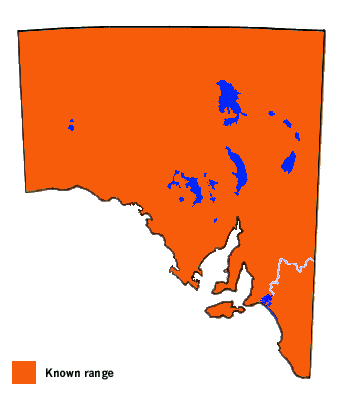Salt-bush Blue
Theclinesthes serpentata serpentata (Herrich-Schaffer)
Interesting Aspects

The butterflies normally fly very close to the foodplants.
Theclinesthes serpentata serpentata (Herrich-Schaffer)

The butterflies normally fly very close to the foodplants.
Larvae feed mainly on saltbushes including Atriplex acutibractea, A. australasica (native orache or green saltbush), A. cinerea (coast saltbush), A. eichleri (Eichler's saltbush), A. elachophylla, A. holocarpa (pop saltbush), A. leptocarpa (slender-fruit saltbush), A. limbata (spreading saltbush), A. lindleyi & ssp (baldoo), A. lobativalvis, A. macropterocarpa, A. morrisii, A. muelleri (annual or Mueller's saltbush), A. nummularia nummularia (old-man saltbush), A. obconica, A. paludosa paludosa (marsh saltbush), A. paludosa cordata (marsh saltbush), *A. pumilio (mat saltbush), A. pseudocampanulata (spreading saltbush), A. quinii (kidney-fruit saltbush), A. rhagodioides (river saltbush), A. semibaccata (berry saltbush), A. spongiosa (pop saltbush), A. suberecta (lagoon saltbush), A. velutinella (sandhill saltbush), A. vesicaria variabilis (bladder saltbush), *Chenopodium album (fat hen or white goosefoot), C. curvispicatum, C. gaudichaudianum (scrambling goosefoot), C. nitrariaceum (nitre goosefoot), Einadia nutans nutans (climbing saltbush), E. nutans oxycarpa (pointed-fruit climbing saltbush), Halosarcia halocnemoides (grey samphire), Rhagodia candolleana candolleana (seaberry saltbush), R. crassifolia (fleshy saltbush), R. eremaea (desert saltbush), R. parabolica (fragrant or mealy saltbush), R. preissii preissii (mallee saltbush), R. spinescens (spiny saltbush) (Chenopodiaceae); also on Atalaya hemiglauca (whitewood) (Sapindaceae). The larvae eat both the leaves and flower heads of the foodplant.
Larvae are attended by a few ants, usually small black or brown Iridomyrmex spp, but occasionally also by a small black sugar-ant Camponotus ceriseipes, small black Monomorium rubriceps, a small red bull-ant of the Myrmecia nigrocincta gp, and a small black Notoncus sp.
Mature larvae are 8-9 mm long.
5-7 mm long.
It is possible to find flying butterflies throughout the year, depending on the region. In the southern areas it is more common during the warmer months from September to May. There is sometimes a mass emergence of the butterfly when hundreds of butterflies are seen flying around the foodplants.

Occurs through much of temperate and subtropical Australia, including Kangaroo Island and Tasmania. Rare in the wet colder areas of South Australia. It is rare or absent along the Pacific coastal shoreline of the eastern states, where it is replaced by Theclinesthes sulpitius. A separate subspecies occurs in Tasmania.
The butterfly may have some degree of dispersal ability (typical of the Polyommatini group of lycaenids), as their adult morphology is uniform and they often turn-up in areas that would normally be considered as unsuitable habitat.

Found wherever its foodplants occur, and these are common and widespread, being present in most habitats.
Locally common in breeding areas and in certain locations may be the most common butterfly.
No major threats.
None required. Will occur in urban gardens.